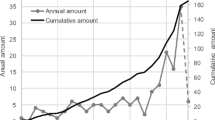Abstract
Goal, Scope and Background
The main aim of this paper is to present some methodological considerations concerning existing methods used to assess quality of the LCA study. It relates mainly to the quality of data and the uncertainty of the LCA results. The first paper is strictly devoted to methodological aspects whereas, the second is presented in a separate article (Part II) and devoted mainly to a case study.
Methods
The presented analysis is based on two well-known concepts: the Data Quality Indicators (DQIs) and the Pedigree Matrix. In the first phase, the Sensitivity Indicators are created on the basis of the sensitivity analysis and then linked with the DQIs and the Quality Classes. These parameters indicate the relative importance of input data and their theoretical quality levels. Next, the Weidema’s Pedigree Matrix (slightly modified) is used to establish the values of the new parameter called the Data Quality Distance (DQD) and to link them with the DQIs and Quality Classes. This way the information about the “real” quality levels is provided. Further analysis is performed using the probabilistic distributions and Monte Carlo simulations.
Results and Discussion
Thanks to this approach it is possible to make a comparison between two types of the quality factors. On the one hand, the sensitivity analysis allows one to check the importance of input data and to determine their required quality. It is done according to the following relation: the higher the sensitivity indicator, the higher the importance of input data and the higher quality should be demanded. On the other hand the data have a certain real quality, not always in accord with the demanded one. To make possible a comparison between these two types of quality, it is necessary to find and develop a common denominator for them. Here, for this purpose the DQIs and Quality Classes are used.
Conclusions
In the further stage of the assessment the DQIs are used to perform the uncertainty analysis of the LCA results. The results could be additionally analysed by using other techniques of interpretation: the sensitivity-, the contribution-, the comparative-, the discernability- and the uncertainty analysis.
Recommendations and Outlook
The presented approach is put into practice to conduct the comparative LCA study for the industrial pumps by using the Ecoindicator99 method. Thanks to this, complex analysis of the credibility of the results is carried out. As a consequence, uncertainty ranges for the LCA results of every product system can be determined [1].
Similar content being viewed by others
References
Lewandowska A, Foltynowicz Z (2004): Comparative LCA of Industrial Objects. Part II — Case study for chosen industrial pumps. Int J LCA, OnlineFirst < DOI: http://dx.doi.Org/l 0.1065/lca2004.03.152.2>
Björklund AE (2002): Survey of Approaches to Improve Reliability in LCA. Int J LCA 7 (2) 64–72
Fava J, Jensen AA, Lindfors L, Pomper S, Smet B de, Warren J, Vigon B (1992): Life-Cycle Assessment Data Quality: A Conceptual Framework; SETAC Workshop Report, Wintergreen, USA
Weidema BP, Wesnaes MS (1996): Data Quality Management for Life Cycle Inventories — An Example of Using Data Quality Indicators. Journal of Cleaner Production 4 (3-4) 167–174
Van den Berg N; Huppes G, Lindeijer E, Van der Ven B, Wrisberg N. (1999): Quality Assessment for LCA. CML Report 152. CML, Leiden University, The Netherlands
Ansemes A, Lighart TN (2002): Data certification for LCA comparisons: Inventory of current status and strength and weakness analysis. TNO-Report, The Netherlands
Barnthouse L, Fava J, Humphreys K, Hunt R, Laibson L, Noesen S, Owens J, Todd J, Vigon B, Weitz K, Young J (1997): Life-Cycle Impact Assessment: The State-of-the-Art. SETAC Report, Pensacola, USA
Huijbregts AJM (1998): Application Uncertainty and Variability in LCA. Part I: Int J LCA 3 (5) 273–280. Part II: Int J LCA 3 (6) 343-351
Huijbregts AJM, Norris G, Bretz R, Ciroth A, Maurice B, Bahr B von, Weidema B, Beaufort ASH de (2001): Framework for Modelling Data Uncertainty in Life Cycle Inventories. Int J LCA 6 (3) 127–132
Norris G (2002): The Many Dimensions of Uncertainty Analysis in LCA; Athena Sustainable Materials Institute. <http://www.athenasmi. ca/papers/down papers/UncertaintyAnalysis in LCA.pdfgt;
Canter K, Kennedy D, Montgomery D, Keats J, Carlyle W (2002): Screening Stochastic Life Cycle Assessment Inventory Models. Int J LCA 7 (1) 18–26
International standard ISO 14043 (2000): Environmental Management — Life Cycle Assessment — Life Cycle Interpretation. The International Standardization Organization. Geneva, Switzerland
International standard ISO/TR 14049 (2000): Environmental Management — Life Cycle Assessment — Examples of application of ISO 14041 to goal and scope definition and inventory analysis. The International Standardization Organization. Geneva, Switzerland
Almemark M, Bjuggren C, Granath J, Olsson J, Röttorp J, Lindfors LG (2000): Analysis and Development of the Interpretation Process in LCA. IVL Rapport, Stockholm, Sweden
Heijungs R, Kleijn R (2001): Numerical approaches towards life cycle interpretation: Five examples. Int J LCA 6 (3) 141–148
Weidema BP, Cappellaro F, Carlson R, Notten P, Palsson AC, Patyk A, Regalini E, Sacchetto F, Scalbi S (2001): Procedural guideline for collection, treatment and quality documentation of LCA data. EU-Project CASCADE
Vose D (1996): Quantitative Risk Analysis. A Guide to Monte Carlo Simulation Modelling. John Wiley & Sons
Author information
Authors and Affiliations
Corresponding author
Rights and permissions
About this article
Cite this article
Lewandowska, A., Foltynowicz, Z. & Podlesny, A. Comparative lca of industrial objects part 1: lca data quality assurance — sensitivity analysis and pedigree matrix. Int J LCA 9, 86–89 (2004). https://doi.org/10.1007/BF02978567
Received:
Accepted:
Issue Date:
DOI: https://doi.org/10.1007/BF02978567




